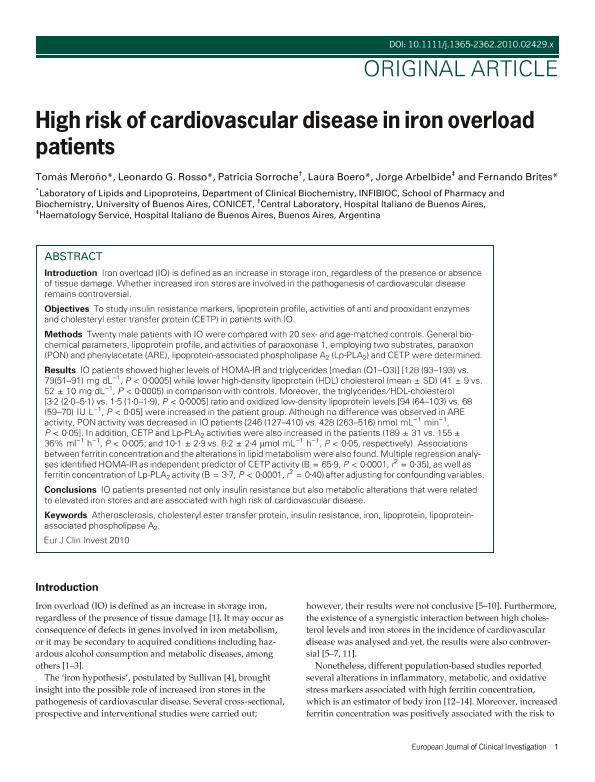Artículo
High risk of cardiovascular disease in iron overload patients
Meroño, Tomás ; Gomez Rosso, Leonardo Adrián
; Gomez Rosso, Leonardo Adrián ; Sorroche, Patricia; Boero, Laura; Arbelbide, Jorge; Brites, Fernando Daniel
; Sorroche, Patricia; Boero, Laura; Arbelbide, Jorge; Brites, Fernando Daniel
 ; Gomez Rosso, Leonardo Adrián
; Gomez Rosso, Leonardo Adrián ; Sorroche, Patricia; Boero, Laura; Arbelbide, Jorge; Brites, Fernando Daniel
; Sorroche, Patricia; Boero, Laura; Arbelbide, Jorge; Brites, Fernando Daniel
Fecha de publicación:
05/2011
Editorial:
Wiley Blackwell Publishing, Inc
Revista:
European Journal of Clinical Investigation
ISSN:
0014-2972
Idioma:
Inglés
Tipo de recurso:
Artículo publicado
Clasificación temática:
Resumen
Introduction: Iron overload (IO) is defined as an increase in storage iron, regardless of the presence or absence of tissue damage. Whether increased iron stores are involved in the pathogenesis of cardiovascular disease remains controversial.Objectives: To study insulin resistance markers, lipoprotein profile, activities of anti and prooxidant enzymes and cholesteryl ester transfer protein (CETP) in patients with IO.Methods: Twenty patients with IO were compared with 20 sex and age-matched controls. General biochemical parameters, lipoprotein profile, and activities of paraoxonase 1, employing two substrates, paraoxon (PON) and phenylacetate (ARE), lipoprotein-associated phospholipase A2 (Lp-PLA2) and CETP were determined.Results: IO patients showed higher levels of HOMA-IR and triglycerides (median [Q1-Q3]) (128[93-193] vs. 79[51-91]mg/dl,p<0.0005) while lower HDL-cholesterol (mean±SD) (41±9 vs. 52±10mg/dl,p<0.0005) in comparison with controls. Moreover, the triglycerides/HDL-cholesterol (3.2[2.0-5.1] vs. 1.5[1.0-1.9],p<0.0005) ratio and oxidized LDL levels (94[64-103] vs. 68[59-70]IU/l,p<0.05) were increased in the patient group. Though no difference was observed in ARE activity, PON activity was decreased in IO patients (246[127-410] vs. 428[263-516]nmol.ml-1.min-1,p<0.05). In addition, CETP and Lp-PLA2 activities were also increased in the patients (189±31 vs. 155±36%.ml-1.h-1,p<0.005; and 10.1±2.9 vs. 8.2±2.4µmol.ml-1.h-1,p<0.05, respectively). Associations between ferritin concentration and the alterations in lipid metabolism were also found. Multiple regression analyses identified HOMA-IR as independent predictor of CETP activity (B=65.9,p<0.0001,r2=0.35), as well as ferritin concentration of Lp-PLA2 activity (B=3.7,p<0.0001,r2=0.40) after adjusting for confounding variables.Conclusions: IO patients presented not only insulin resistance, but also metabolic alterations which were related to elevated iron stores and are associated to high risk of cardiovascular disease.
Archivos asociados
Licencia
Identificadores
Colecciones
Articulos(OCA HOUSSAY)
Articulos de OFICINA DE COORDINACION ADMINISTRATIVA HOUSSAY
Articulos de OFICINA DE COORDINACION ADMINISTRATIVA HOUSSAY
Citación
Meroño, Tomás; Gomez Rosso, Leonardo Adrián; Sorroche, Patricia; Boero, Laura; Arbelbide, Jorge; et al.; High risk of cardiovascular disease in iron overload patients; Wiley Blackwell Publishing, Inc; European Journal of Clinical Investigation; 41; 5; 5-2011; 479-486
Compartir
Altmétricas



